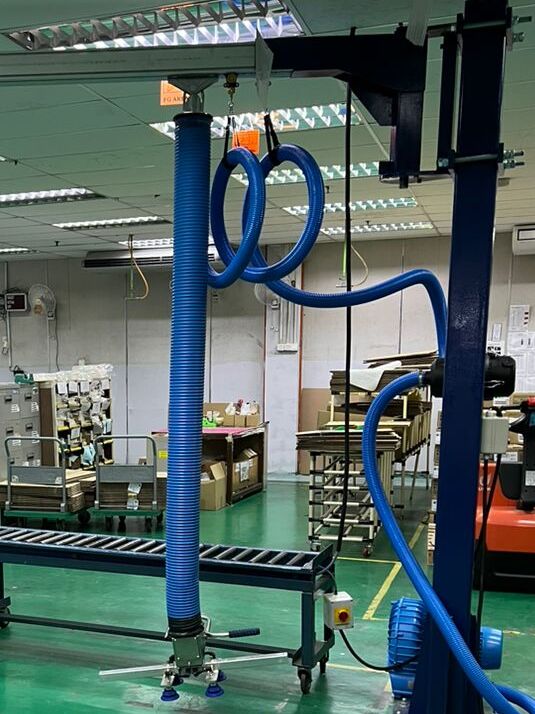In these modern and fast-moving industries, their production processes cannot imagine life without the application of vacuum lifters. This piece of equipment has helped with the automation of their production process. It saves their manpower from destruction or injury while ensuring safety. A vacuum lifter is a sort of device using vacuum technology to lift, move, or position heavy or fragile material to be handled. The tools used under the umbrella of vacuum lifters are amazingly versatile and have wide applications in many industries to handle various tasks.
What is a Vacuum Lifter?
A vacuum lifter is a lifting medium that lifts objects by using the power of suction. It reduces manual labor and adds more safety. Most industries use vacuum lifters to lift fragile or heavy materials with a lot of accuracy. Vacuum lifters speed up and smoothen automation and are quick while in operation. Machines gain familiarity in most companies due to their demand in raising high productivity levels.
Benefits of Vacuum Lifters in Production Automation
- More Efficiency: It allows for greater speed due to the minimal amount of manual handling involved and due to a generally improved workflow.
- Safety Improvement: They minimize the chances of worker injury through the minimization of manual lifting that can stress workers.
- Accurate Handling: Vacuum lifters can position materials in many production processes with much-needed exactitude.
- Diversified Handling: These tools can handle everything from fragile items such as glass to heavy ones like metal sheets.
- Cost Economy: The vacuum lifters save labor costs and speed up production, hence economizing altogether.
Types of Vacuum Lifters
The vacuum lifters are available in a few variants. Each variant represents a unique application. Understanding these variants will let you choose the right vacuum lifter for your application.
Manual Vacuum Lifters
Manual vacuum lifters are operated by hand. They are great for little tasks and lightweight materials. Operating them is very easy; hence, they are very common in smaller businesses. They apply in production automation where human supervision is required. However, they cannot handle heavy-duty applications.
- Usage: Small materials like boxes, sheets of glass, or small metal panels.
- Benefits: Low cost, simple operation for small applications
Electric-Powered Vacuum Lifters
Most industries use electric-powered vacuum lifters in large-scale production environments. They use electricity to perform repetitive tasks more efficiently. These lifters are used in a great many industries where continuous material handling is necessary. Their capacity for lifting with high dimensions makes them apt for automation in factories, able to reduce labor costs by increasing speed in the process.
- Usage: Manipulation of metal sheets, glass panels, and other heavy materials for large-scale production.
- Benefits: Highly efficient, suitable for continuous use, handles heavy materials.
Battery-Powered Vacuum Lifters
The battery-operated vacuum lifters are very versatile and portable. They offer mobility and flexibility in manifold production environments. These battery-operated vacuum lifters easily can fit into any work site where accessibility to electricity is not possible. Applications range from outdoor environments to construction sites. Their portability makes them also efficient in the handling of material over several areas.
- Usage: Ideal for outdoor worksites and those locations where access to electricity may be limited.
- Benefits: Very portable and flexible, hence an excellent implement for use outdoors.
Pneumatic Vacuum Lifters
Pneumatic vacuum lifters create the necessary suction for lifting through compressed air. They are also very common in industries where safety is a priority. Because pneumatic systems do not spark, they are perfectly safe to work in an explosive environment. Pneumatic vacuum lifters are dependable and tough; thus, they are appropriate for hazardous working conditions. They also aid production automation with safe and efficient lifting.
- Usage: Explosive Environments; those containing chemical factories or very highly flammable materials.
- Benefits: Spark-free, highly reliable, and suitable to be used in hazardous environments.
Glass and Window Vacuum Lifters
The name would imply these vacuum lifters are for handling glass and windows. They widely use them in the construction and manufacturing industries to handle large glass panels. Their functioning enables positioning with accuracy and without any risk of damage to fragile materials. Glass and window vacuum lifters provide a wide range of applications in automation when tasks require high precision. They ensure safety and efficiency in material handling.
- Usage: Lifting large glass panels during construction and manufacturing
- Benefits: Moreover, offers accuracy and limits the possibility of damaging fragile items.
Selection of the Correct Vacuum Lifter
The selection of the appropriate vacuum lifter depends on a range of factors. The application differs from one industry to another; hence the following points must be remembered:
- Type of Load: There are types of lifters according to the nature of the load-metal, glass, or wood.
- Weight of the Load: Note that the weight of the materials you are going to lift will always determine the choice of lifter capacity.
- Environment: It is also very important in the selection process. For example, pneumatic lifters will do well in hazardous areas.
- Power Source: Based on where the lifter is going to be employed, one may need to get an electric, battery, or pneumatic lifter.
- Frequency of Use: The frequency at which the vacuum lifter is going to be used has to be considered. Moreover, for heavy-duty and continuous applications, electric-powered lifters provide the most efficiency.
Applications of Vacuum Lifters across Industries
Lifters are being used in a wide range of industries with varied applications. The following are major industries for which the use of vacuum lifters is indispensable:
Construction Industry
These are the vacuum lifters designed for construction to handle heavy materials like glass, concrete, and steel. They are fast methods of operation and safe to conduct lifting activities on a construction site. They are good at handling fragile glass panels during the process of building.
Manufacturing Industry
Manufacturing industries highly rely on a vacuum lifter to ease the production process. A vacuum lifter is an ideal tool for automating handling materials such as metal sheets, wood panels, and plastic sheets. For production automation, they hugely raise productivity with full accuracy.
Warehouse and Logistics
Lifting vacuums are also very common in warehouses and logistics, where they deal with handling boxes, pallets, and even crates. Such lifters make the task of loading and unloading materials quite easier. They reduce physical effort on employees while improving efficiency.
Chemical Industry
Pneumatic vacuum lifters are very common in the chemical industry, owing to their suitability for hazardous environments. These lifters handle drums, containers, and other heavy-duty equipment in areas with explosive materials.
Conclusion
Vacuum lifters are an indispensable means in today’s production environment. They promote efficiency by going on to improve safety, simplify processes, and thereby increase efficiency in many sectors. Whether manual, electric, battery-driven, or pneumatic, each variant of vacuum lifter serves certain special purposes. The choice of vacuum lifter also includes your needs, types of materials, and working environment. Investing in the proper type of vacuum lifter will go a long way in bringing improvements to your production automation and helping to provide long-term success.






